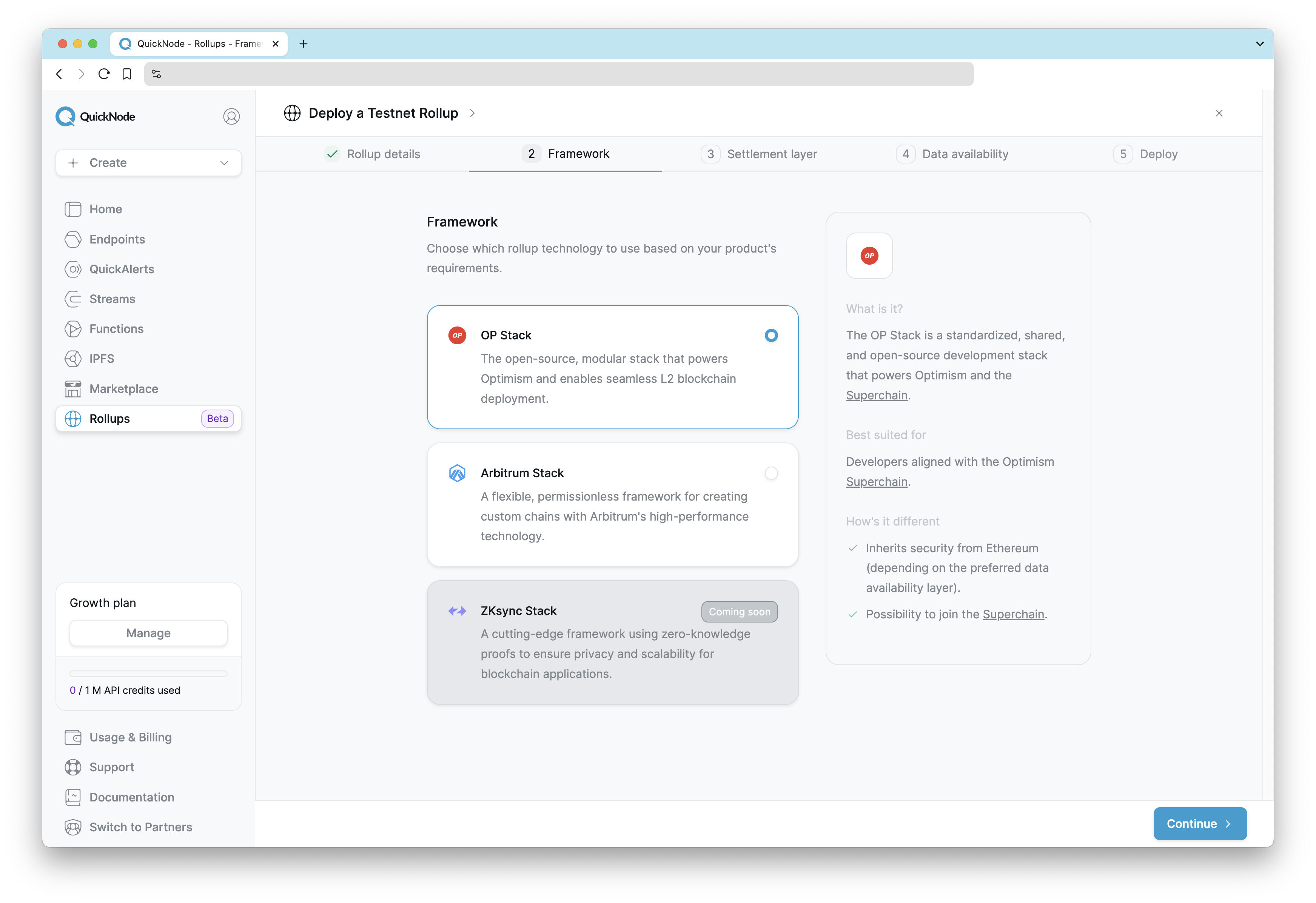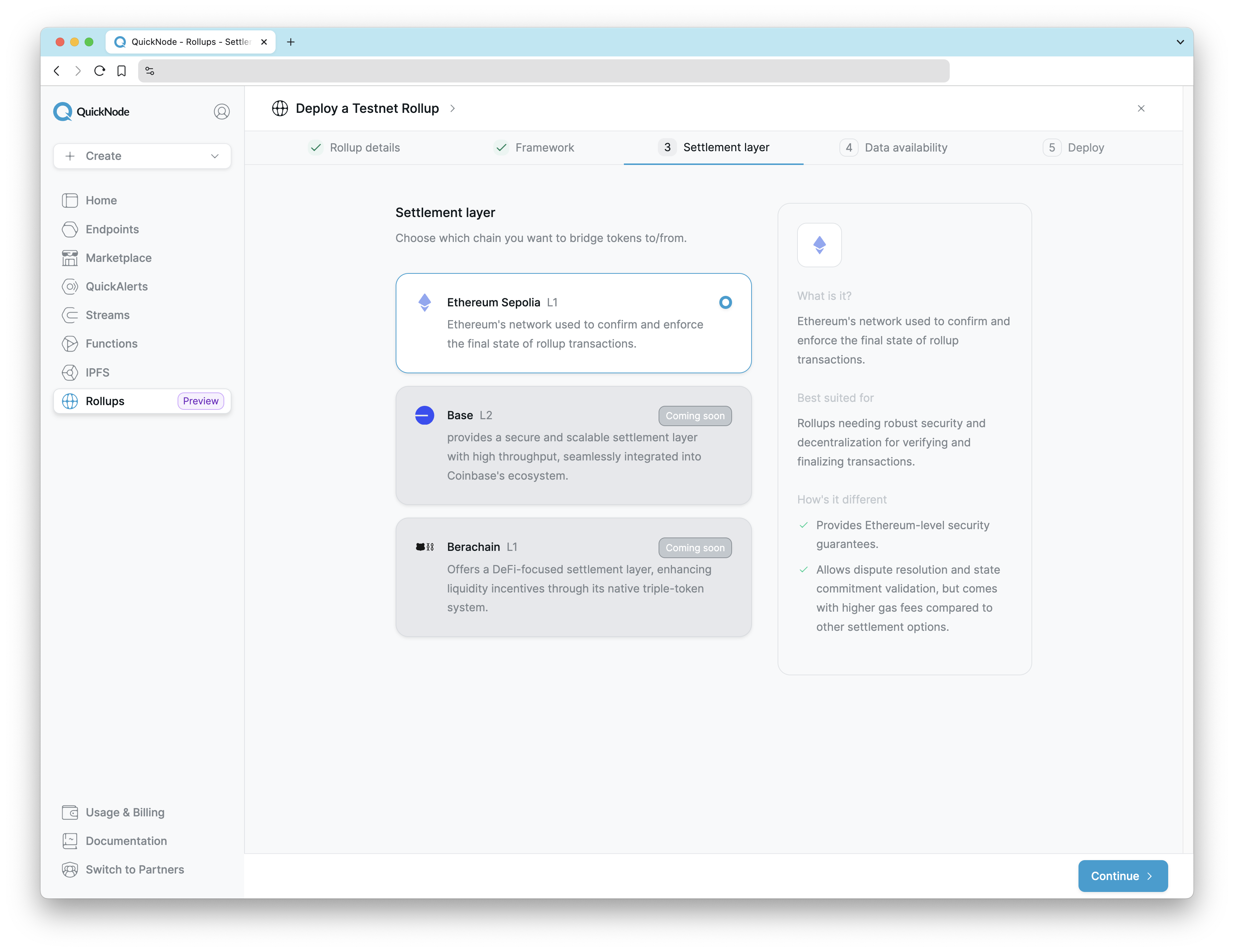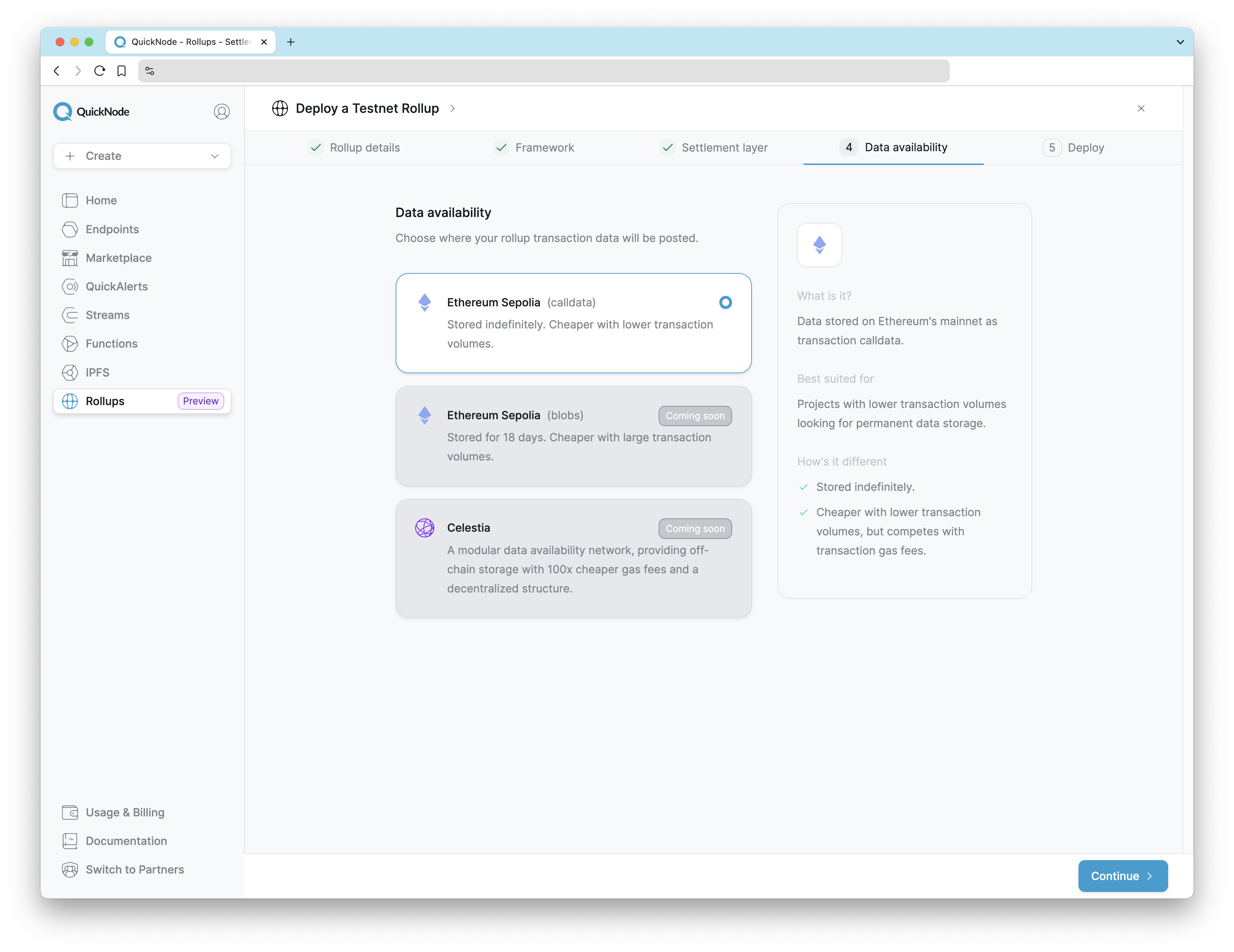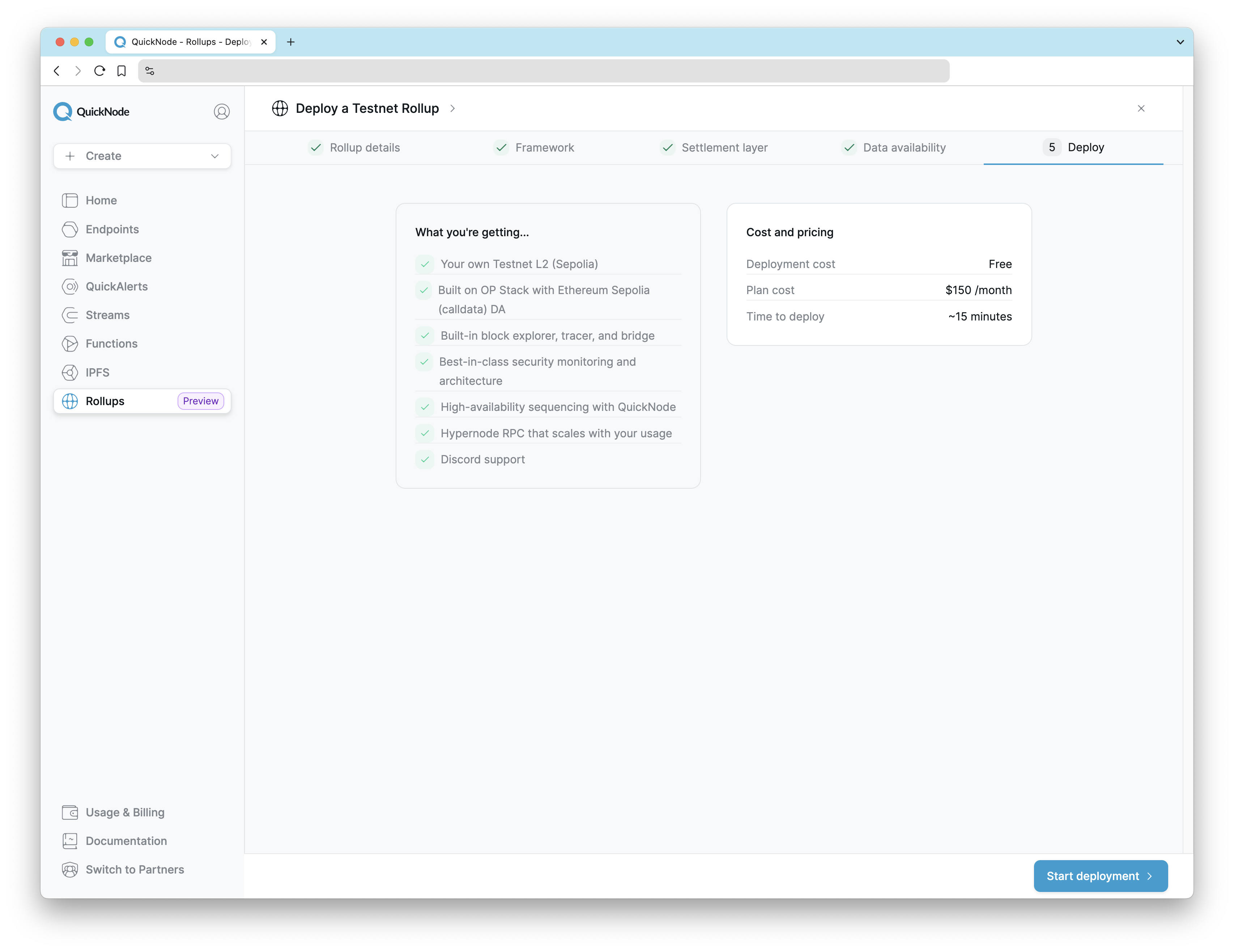7 min read
Overview
In this guide, we’ll walk you through the process of deploying your own Optimism Layer 2 (L2) rollup using QuickNode’s Rollup-as-a-Service (RaaS) product. We will be utilizing the OP Stack, a modular framework to simplify the creation of scalable Layer 2 (L2) and Layer 3 (L3) blockchains on Ethereum. Currently, you will be able to deploy your rollup on the Ethereum Sepolia testnet, with mainnet support coming soon.
By the end of this guide, you’ll be equipped with the knowledge and tools needed to launch and manage a scalable, secure, and reliable OP Stack rollup, tailored to your specific needs.
Deployment of OP Stack Rollups via QuickNode's RaaS product is currently temporarily paused. Please stay tuned for further updates on when deployments will resume. If you have questions, please contact us directly.
What You Will Do
- Learn about Rollup-as-a-Service (RaaS) and how it simplifies rollup deployment
- Explore OP Stack and its configuration options
- Deploy your own Optimism L2 rollup using QuickNode’s Rollup-as-a-Service
What You Will Need
- A QuickNode account on the Build plan or higher
- Basic understanding of blockchain
- Familiarity with core concepts in rollup configuration, as outlined in the Essential Rollup Fundamentals for Your First Deployment (Highly recommended)
For a more detailed exploration of blockchain development, check out our Launch Your Own Blockchain guide. This guide covers everything from the basics to advanced strategies, helping you make informed decisions before starting your rollup project. If you need additional help, talk with one of our experts to find out how to make your next project a success.
In this guide, we’ll focus on Optimistic Rollups using the OP Stack, leveraging QuickNode’s Rollup-as-a-Service (RaaS) for an easy and efficient deployment process.
What is Rollups-as-a-Service (RaaS)?
Rollups are an essential part of scaling blockchain technology, especially as demand for decentralized applications (dApps) continues to grow. However, deploying and managing rollups can be complex, requiring significant resources and expertise. This is where Rollup-as-a-Service (RaaS) comes in, simplifying the process and making it accessible to a wider audience. It allows developers and companies to build their own Layer 2 rollup chains without needing deep technical knowledge or large infrastructure.
By providing a comprehensive stack of tools, templates, and infrastructure, RaaS platforms enable users to create rollups —whether general-purpose or application-specific— without the need for extensive technical expertise or heavy infrastructure investments.
Why Choose Rollups with QuickNode?
Deploying and managing rollups can be complex, especially when reliability, security, and scalability are paramount. QuickNode’s Rollup-as-a-Service addresses these challenges by providing a streamlined solution that emphasizes long-term success.
Benefits of Using QuickNode for Rollups:
- Enterprise-Grade Infrastructure: QuickNode’s infrastructure is designed to support enterprise-grade rollups, ensuring high performance and security from the start.
- Dedicated Clusters: With dedicated clusters, your rollup benefits from optimal performance and reliability, free from the risks of shared environments.
- Comprehensive Tooling: QuickNode offers all the tools (i.e., block explorer, validator tools, API indexer, scalable RPC, testnet faucet) you need to manage your rollup, making it easier to maintain and optimize your rollup.
- Security and Reliability: With 99.99% uptime SLAs and, SOC1 Type 2 and SOC2 Type 2 certifications, you can trust that your rollup will remain operational and secure, protecting your revenue and customer trust.
- Scalability: As your rollup grows, QuickNode’s infrastructure scales seamlessly, maintaining high performance even under increased demand.
Now that you understand the benefits of rollups and Rollup-as-a-Service of QuickNode, let's dive into the step-by-step process of deploying your own Optimism L2 rollup.
How to Deploy Your Own Optimism L2 Rollup
Now that we have everything in place, let's jump into the deployment process.
Step 1: Start a New Rollup Deployment
To get started, log in to your QuickNode account.
- On the sidebar, click the Rollups section to access the Rollup-as-a-Service dashboard.
- Click the Deploy a New Rollup button to start the process of setting up your Optimism Layer 2 rollup.
If you don't have a QuickNode account yet, create a free one here.
Step 2: Configure Rollup Details
In this step, you’ll set up the basic details for your rollup.
- Rollup Name: Modify the name for your rollup or leave it as is. Remember, the name cannot be changed once the rollup is deployed.
- Admin Address: Add the public address of a multi-signature wallet or a wallet that you control. This wallet will act as the admin and be responsible for managing contract upgrades, rotating the sequencer address, and making rollup configuration changes.
- Chain ID: The Chain ID is a unique identifier for your rollup’s chain and cannot be modified.
Step 3: Select Framework
Here, you will choose the framework on which to build your rollup. Select the OP Stack as your framework for this deployment.
OP Stack, built by the Optimism Collective, powers the Optimism network and facilitates launching Layer 2 (L2) and Layer 3 (L3) chains. With its modular design, developers can customize various layers, such as consensus and execution, to align with specific use cases. OP Stack aims to build a Superchain, a network of interoperable OP Stack chains, each able to communicate seamlessly within this ecosystem.
For more details, check out here.
ZKsync Stack will be available in the future.
Step 4: Choose Settlement Layer
Next, decide where your rollup will settle its transactions. The settlement layer is where the final state of transactions is recorded and where disputes over transaction validity are resolved. For Optimism L2 rollups, generally Ethereum acts as the settlement layer, providing:
- High Security: Ethereum's decentralized network ensures that the final state of transactions is secure and tamper-proof.
- Trustless Bridge: Allows for secure and decentralized transfers of assets between Layer 1 (Ethereum) and Layer 2 (your rollup).
- Dispute Resolution: Ensures that any disputes over transaction validity are handled in a trustless, secure manner, leveraging Ethereum's robust consensus mechanism.
Select Ethereum Sepolia (L1) as the settlement layer for this guide.
Other alternatives, such as Base and Berachain, will be available soon.
Step 5: Select Data Availability Solution
Data availability refers to how and where your rollup stores its transaction data. Ensuring data availability is critical because it guarantees that all necessary transaction data is accessible for verification and dispute resolution. Data can be stored either onchain or offchain using different data availability solutions. For more details, check out here.
We currently support only calldata onchain data availability for OP Stack rollups, with coming support for blobs and Celestia in the near future.
Choose calldata on Ethereum Sepolia as the current data availability solution.
Step 6: Review and Deploy Your Rollup
Before finalizing, review all configuration details to ensure everything is set up correctly.
- Review your rollup’s name, chain ID, admin address, framework, settlement layer, and data availability settings.
- Take note of the features QuickNode provides:
- Your own blockchain
- Built-in block explorer, tracer, and bridge
- Best-in-class security monitoring and architecture
- High-availability sequencing with QuickNode
- Hypernode RPC scaling with your usage
- Discord support for technical assistance
- Review the pricing and estimated deployment time.
- Click Start deployment to begin deploying your rollup.
Step 7: Monitor Your Rollup
Once deployed, you can view and manage your rollup from the QuickNode dashboard. You’ll have access to detailed insights and management tools.
Overview Page: This page provides a high-level view of your rollup's performance.
- RPC Endpoint Activity: Monitor RPC requests over a selected period.
- Performance Metrics: View statistics like total requests, requests per second, network activity, transactions, and block times.
- Sequencer Transactions: See details of the transactions handled by your sequencer.
- Rate Limit and Whitelisting: Manage rate limits and set IP whitelisting for security.
- Endpoint Management: Oversee and manage your rollup’s endpoint configuration.
Contracts Page: Here, you can access the details of all contracts related to your rollup.
Faucet Page: The Faucet page lets you distribute tokens to specific addresses.
Interacting with Your Rollup
Once your Optimism L2 rollup is deployed, you can start interacting with it just like you would with any EVM-compatible chain. Below are some basic methods to get started:
Interacting via cURL
You can use curl commands to interact with your rollup’s RPC endpoint directly. Here's an example of how to check the latest block:
curl -X POST https://<your-rollup-rpc-endpoint> \
-X POST \
-H "Content-Type: application/json" \
--data '{"method":"eth_blockNumber","params":[],"id":1,"jsonrpc":"2.0"}'
This command will return the current block number of your rollup in hexadecimal format.
Interacting via EVM-Compatible Libraries
Since your rollup is EVM-compatible, you can also use popular libraries like ethers.js or web3.js to interact with your rollup. These libraries allow you to perform various actions, such as sending transactions, reading contract data, and listening to events.
Here’s an example of using ethers.js to interact with your rollup:
import { ethers } from "ethers";
(async () => {
const provider = new ethers.JsonRpcProvider("https://<your-rollup-rpc-endpoint>");
const blockNum = await provider.getBlockNumber();
console.log(blockNum);
})();
You can now access Logs for your RPC endpoints, helping you troubleshoot issues more effectively. If you encounter an issue with your RPC calls, simply check the logs in your QuickNode dashboard to identify and resolve problems quickly. Learn more about log history limits on our pricing page.
For more detailed examples and in-depth guidance on interacting with Optimism rollups, you can refer to QuickNode's Optimism documentation, which covers many of the common methods and tools available for interacting with Optimism-based chains.
Conclusion
Deploying your own Optimism Layer 2 rollup with QuickNode’s Rollup-as-a-Service (RaaS) is a powerful way to scale your blockchain application while maintaining security, performance, and reliability. By following the steps outlined in this guide, you now have the tools and knowledge to customize your rollup according to your project’s specific needs, leveraging the flexibility and modularity of the OP Stack.
Whether you're building a dApp that requires high throughput, deploying a specialized blockchain for enterprise use, or exploring the potential of Layer 2 solutions, QuickNode’s RaaS provides the infrastructure and support you need to succeed.
If you have questions, any ideas or suggestions, please contact us directly. Also, stay up to date with the latest by following us on Twitter and joining our Discord and Telegram announcement channel.
Additional Resources
- QuickNode’s Rollup-as-a-Service (RaaS)
- Step-by-Step Technical RaaS Guides
- Blog Articles on QuickNode Rollups
- Launch Your Own Blockchain - Builder's Guide
- QuickNode's Optimism Documentation
- Optimism's OP Stack Documentation
We ❤️ Feedback!
Let us know if you have any feedback or requests for new topics. We'd love to hear from you.




